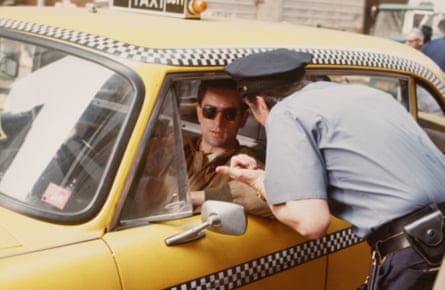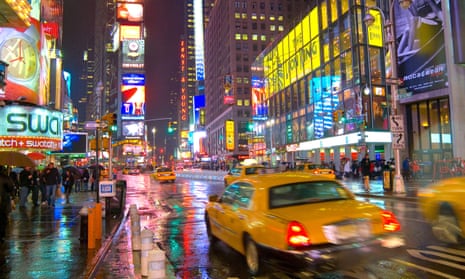The yellow taxis of Manhattan have long been part of the city’s fabric, their energy woven into New York’s enduring cultural mythology, from the comedy of Taxi to Robert de Niro’s Travis Bickle in Taxi Driver.
But the system of city-licensed yellow cabs could now be breaking down, taking with it a key stepping stone to a middle-class life for waves of immigrants who make up more than 90% of drivers.
A Morgan Stanley report has found that in April 2016, the 13,587 yellow cabs in New York City completed 11m trips – a fall of 9% on the previous year. In the same month, 5.5m Uber, Lyft and car-service trips were made. The shift is expected to accelerate as app-based services gain ground, savaging the underlying economics of the yellow-cab business.
“Yellow cabs are finished,” a black-car driver, Jagdish, said last week. “Uber stole all the business.”
Two years ago, Jagdish said, his brother paid $630,000 for a medallion, or permit, for a yellow cab. “Now it’s worth half of that. He’s got two kids and he’s barely making ends meet.” Black cars – car-service vehicles booked by telephone – are doing no better, he added.
Prices for medallions licensed by the city’s Taxi and Limousine Commission peaked at more than $1m in 2013. Now, declining values have left many operators financially underwater. Individual owner-drivers may be hardest hit, caught in a credit crunch.
Sitting in an Indian café favored by taxi drivers in Chelsea, Jagdish said immigrants should be warned that driving a car for a living is no longer a way into the middle class.
“If you want to punish somebody,” he said, “tell them to come to New York and drive for a living. If you don’t like someone, get them to do this.”
Three New York-based credit unions specialising in loaning money against medallions have been placed in administration. The fleet of yellow taxis is looking increasingly ramshackle and road-worn.
One driver said it had become difficult to compete with services like Uber, in part because yellow cabs are often fleet-owned, driven 24 hours a day and dirty. Uber cars, privately owned and operated, are not under the same pressures of use.
“Everybody likes Uber because it’s neat and clean,” said Utpal Sarkar, who came to the US from Pakistan six years ago, while driving a battered Honda. While he earns less than an Uber driver, he said, he still pulled in twice what he earned from shifts at Dunkin’ Donuts.

‘There could be a silver lining to this’
Uber’s popularity is not universal. In New York City, which faces a crisis over the dilapidation of its subway and rail systems, the boom in app-based rides has led to increased congestion.
A Schaller Consulting report issued in February found that app-based services have caused a increase of 600m vehicle miles annually, or a 3% to 4% jump in citywide traffic. Average traffic speed has dropped from 12mph in to 2011 to 8.1mph now.
The crisis has put pressures on the city’s mayor, Bill de Blasio, who faces re-election later this year, and Democratic state governor Andrew Cuomo, who controls the purse strings of public transport and is rumored to be eyeing a presidential run in 2020.
Earlier this year, de Blasio said he would not bail out the yellow-cab industry or seek to curb the newcomers. “Free-market dynamics … created an opening for Lyft, Uber and others,” he said, “and the taxi industry has to learn from that.”
Economists echo de Blasio’s position. One, Keith Leggett, reasons that the yellow-cab industry was for years protected from competition but is “now having to adapt to a nimble competitor, so we’re seeing a lot of pain for medallion owners”. The yellow cabs’ market share may have shrunk dramatically, “but they still represent the majority of rides in the city”.
Supporters of the yellow cabs claim app-based services enjoy advantages, such as not paying a public transportation improvement surcharge.
If the industry is indeed at a crossroads, what is New York in danger of losing? Graham Hodges, author of Taxi!, a social history of New York’s “hackers”, said “the New York City cab driver personifies the energy and zeal” of the city, and hacking remains “one of the great acculturating forces in American society”.
The fall in value of taxi medallions could ultimately tease out fleet owners and allow small individual operators to prosper as they once did, Hodges said.
“There could be a silver lining to this. People who invested in medallions at very high prices are mostly fleet owners and brokers. The drop in the price of medallions could make it more affordable for the average owner-driver.”
Hodges believes there is little likelihood city government will simply relinquish control of the yellow-cab system to Uber and Lyft, and predicts the refusal of the political class to deal with the plight of yellow cabs will ultimately backfire as congestion contributes to some “tragic accident” that will force politicians to act.
“When that happens it’s not going to be the medallion operations that lose out but these other services that are only quasi-legitimate to begin with,” he said. “There is a future for the taxi industry and future for the value of medallion.
“And I’d make a strong case for bonds of attachment between drivers and the city.”

Comments (…)
Sign in or create your Guardian account to join the discussion